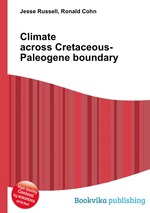Climate across Cretaceous-Paleogene boundary
Jesse Russell Ronald Cohn
бумажная книга
High Quality Content by WIKIPEDIA articles! The climate across the Cretaceous-Paleogene boundary (K-Pg or formerly the K-T Boundary) is very important to geologic time as it marks a catastrophic global extinction event. Numerous theories have been proposed as to why this extinction event happened including an asteroid known as the Chicxulub asteroid, volcanism, or sea level changes. While the mass extinction is well documented, there is much debate about the immediate and long term climatic and environmental changes caused by the event . The terrestrial climates at this time are poorly known which limit the understanding of environmentally driven changes in biodiversity that occurred before the Chicxulub crater impact. Oxygen isotopes across the K-T boundary suggest that oceanic temperatures fluctuated in the Late Cretaceous and through the boundary itself. Carbon isotope measurements of benthic foramifinera at the K-T boundary suggest rapid, repeated fluctuations in oceanic productivity in the 3 million years before the final extinction, and that productivity and ocean circulation ended abruptly for at least tens of thousands of years just after the boundary, indicating devastation of terrestrial and marine ecosystems. Some researchers suggest that climate change is the main connection between the impact and the extinction. The impact perturbed the climate system with long term effects that were much worse than the immediate, direct consequences of the impact.


